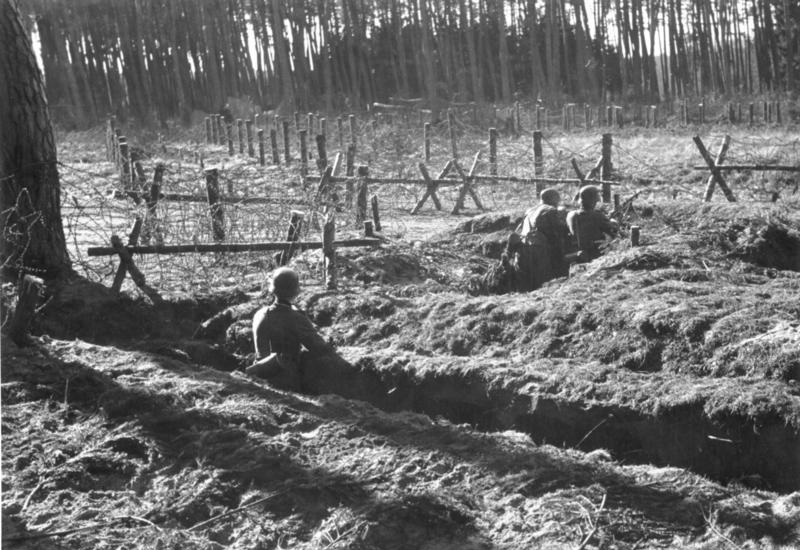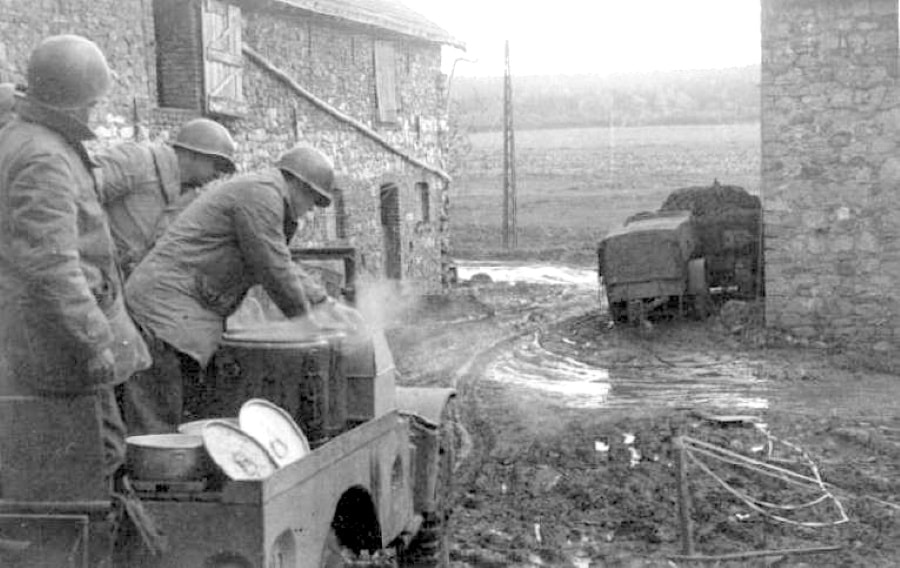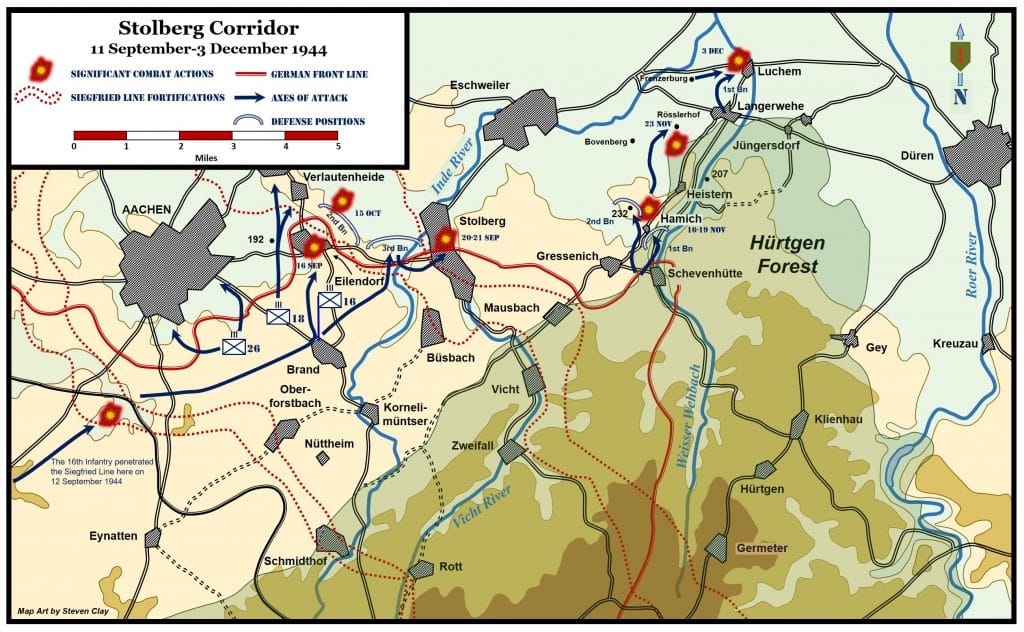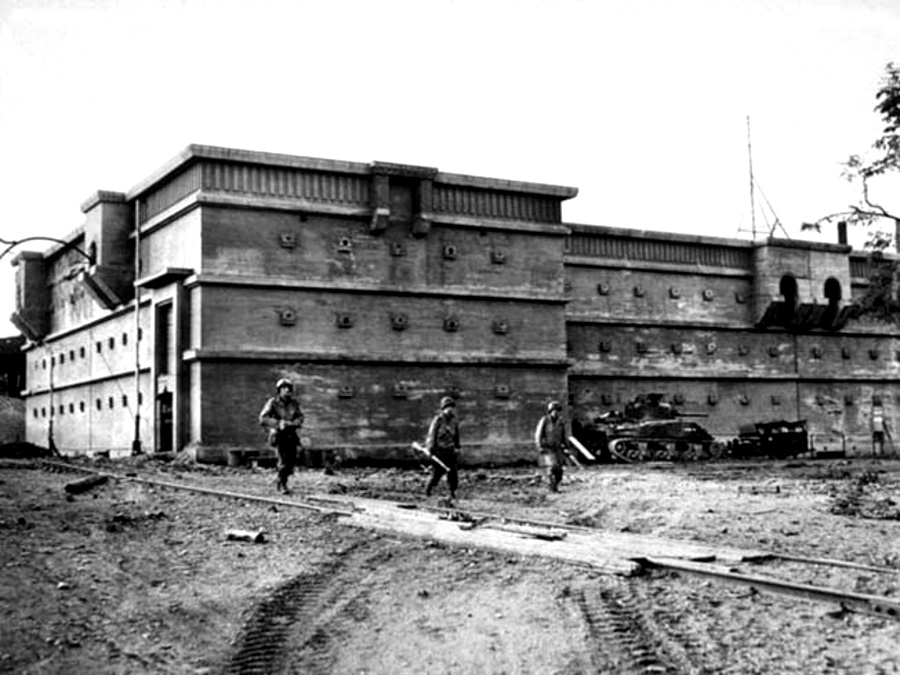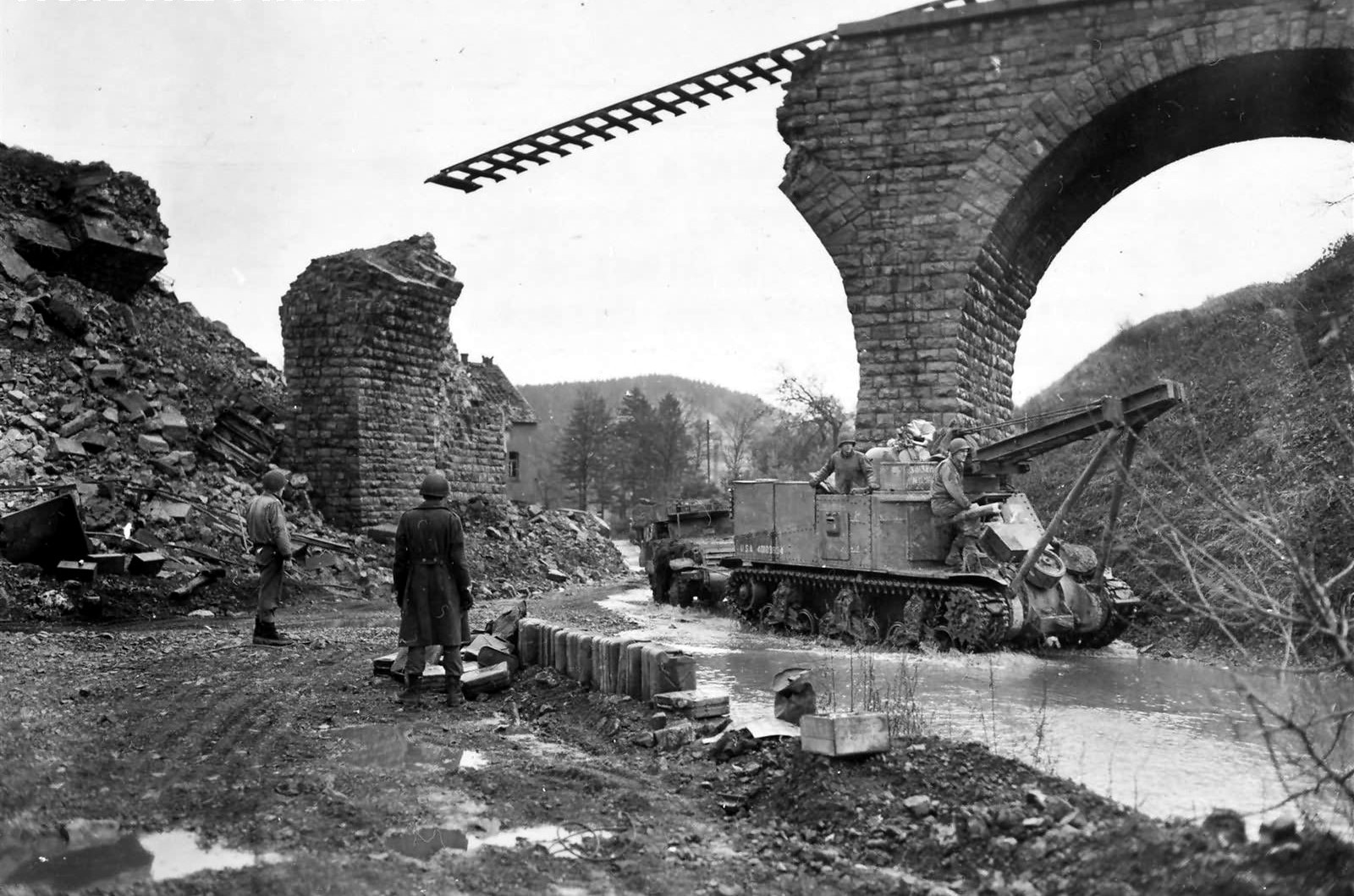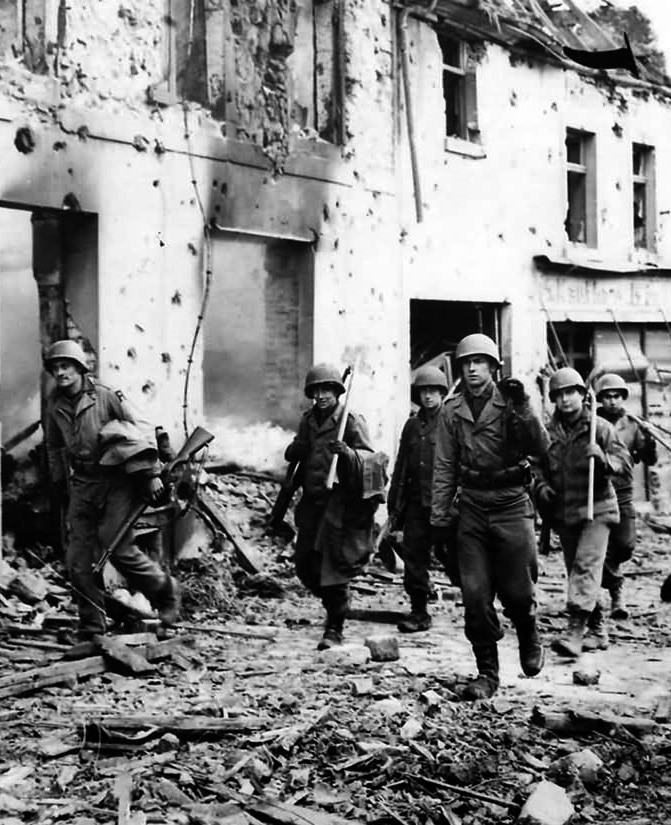 Strength Reports, 9.Pz Div to LXXXI Corps 16 and 21 Sep and Comments on Strength Report of 9.Pz Div; LXXXI Corps G-3 Off, 16 Sep 44; LXXXI Corps KTB, Meldungen der Div; Tabulation of Tanks and AT Weapons, LXXXI Corps, 2200 on 17 Sep 44, LXXXI Corps KTB, Tagesmeldungen; Report, Gen Brandenberger to Army Gp B, 16 Sep 44, LXXXI Corps KTB, Befehle: Heeresgruppe, Army, usw.; LXXXI Corps to 9.Pz Div, 1500 on 15 Sep 44 and FM Model to CofS, 7.Army, 1350 on 16 Sep 44, and 17 Sep 44, LXXXI Corps KTB, Kampfverlauf; TWX (Weekly Strength Report as of 1200 on 16 Sep 44), LXXXI Corps to 7.Army, 22 Sep 44, and Tabulation of Armored Vehicles, LXXXI Corps, 16 Sep 44, LXXXI Corps KTB, Befehle an Div. usw.; TWX, A Gp B to OB WEST, 2350 on 22 Sep 44, A Gp B KTB, Operations-Befehle.
Strength Reports, 9.Pz Div to LXXXI Corps 16 and 21 Sep and Comments on Strength Report of 9.Pz Div; LXXXI Corps G-3 Off, 16 Sep 44; LXXXI Corps KTB, Meldungen der Div; Tabulation of Tanks and AT Weapons, LXXXI Corps, 2200 on 17 Sep 44, LXXXI Corps KTB, Tagesmeldungen; Report, Gen Brandenberger to Army Gp B, 16 Sep 44, LXXXI Corps KTB, Befehle: Heeresgruppe, Army, usw.; LXXXI Corps to 9.Pz Div, 1500 on 15 Sep 44 and FM Model to CofS, 7.Army, 1350 on 16 Sep 44, and 17 Sep 44, LXXXI Corps KTB, Kampfverlauf; TWX (Weekly Strength Report as of 1200 on 16 Sep 44), LXXXI Corps to 7.Army, 22 Sep 44, and Tabulation of Armored Vehicles, LXXXI Corps, 16 Sep 44, LXXXI Corps KTB, Befehle an Div. usw.; TWX, A Gp B to OB WEST, 2350 on 22 Sep 44, A Gp B KTB, Operations-Befehle.
To sum up, on September 15, the 9.Panzer-Division with attached units had an infantry combat strength of roughly 2500 men, approximately 200 machine guns, 13 Mark V Panthers, 12 assault guns, about 15 75-MM AT guns, 15 150-MM howitzers, 20 105-MM howitzers, 1 88-MM, 3 37-MM, and 3 20-MM AAA guns. As a result of the highly inadequate signal communications, the frontage of the 9.Panzer-Division had proved too wide for the effective exercise of command.
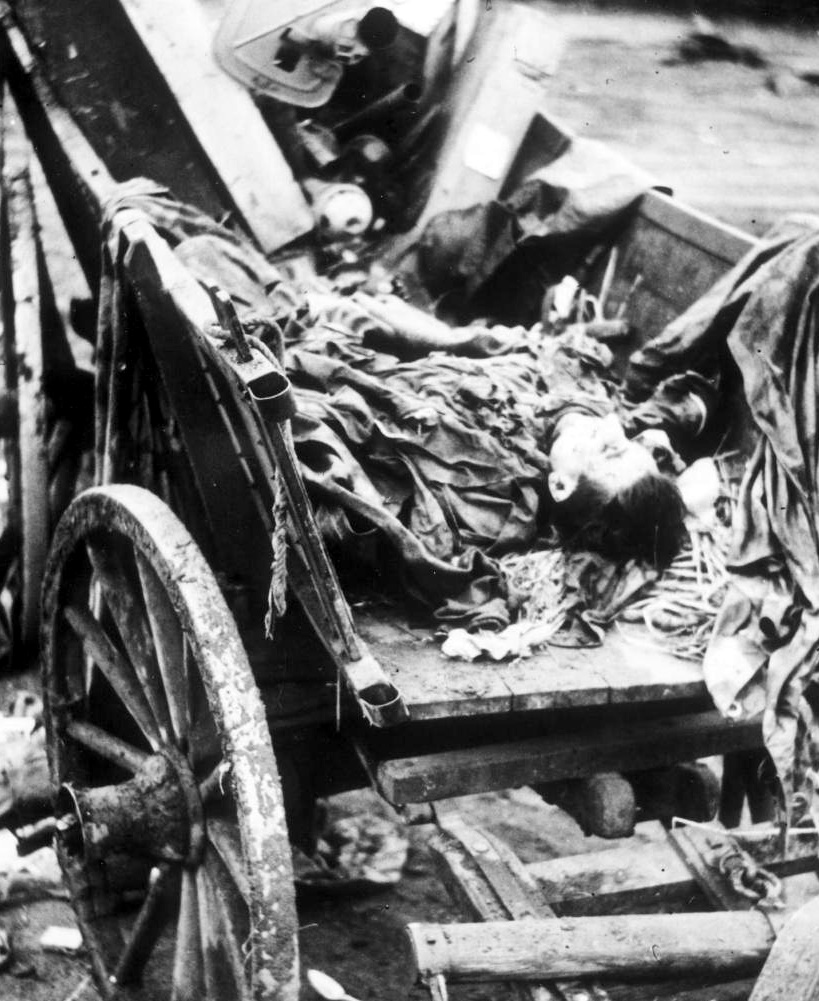
 To remedy this condition the LXXXI Corps committed the Hqs 353.Infantry-Division with 2 companies of Landesschuetzen (possibly Landesschuetzen Bn II/6) in the southern half of the 9.Panzer-Division sector.
To remedy this condition the LXXXI Corps committed the Hqs 353.Infantry-Division with 2 companies of Landesschuetzen (possibly Landesschuetzen Bn II/6) in the southern half of the 9.Panzer-Division sector.
The new boundary between the 9.Panzer and the 353.Infantry extended from Schevenhuette, Jaegerfahrt (north of Zweifall), Vennwegen, Hahn, and Schmidthof to Raeren. In the south the new sector of the 353.Infantry was defined by the boundary between the LXXXI and the LXXIV Corps.
For the defense of this sector, elements of the 9.Panzer-Division were attached to the 353.Infantry-Division, the Hqs 253.Grenadier-Training-Regiment under Col Feind with the 328.Replacement-Training-Battalion, Replacement Battalion Nagel, remaining elements of the almost completely smashed Landesschuetzen Bn I/9 and of the 547.Security-Battalion, a heavy weapons company, about 8 75-MM AT guns and one battery of 3 150-MM howitzers.
With these forces the combat strength of 353.Infantry-Division rose to roughly 700 men. The 9.Panzer-Division was left with a combat strength of 56 officers and 1941 enlisted men, organized in two Kampfgruppen under the command, respectively, of Maj Volkerand Col Max Sperling (presumable commander of 33.Panzer-Regiment). The rear area functions of 353.Infantry-Division was assumed by Kampfgruppe Jungklaus, a rear area headquarters subordinate to the LXXXI Corps, with orders to rally all stragglers in the communications zone and to begin work on a blocking line between the Geilenkirchen – Rheydt Rail Line and the left boundary of the LXXXI Corps, the Roer Position or Schlieffen Line. Late in the evening of September 15, Gen Schack received the cheering news that the first elements of 12.Infantry-Division would arrive at Jülich and Düren during the night and that the transport of the entire division would be completed some 30 hours later. The LXXXI Corps ordered the division to assemble in the Aldenhoven, Pattern, Inden, Lamersdorf, Eschweiler, Laurensberg area.
 LXXI Corps to Kampfgruppe Gruppe Jungklaus
LXXI Corps to Kampfgruppe Gruppe Jungklaus
at 1830 on 15 Sept 44, LXXXI Corps KTB
Befehle a Division.
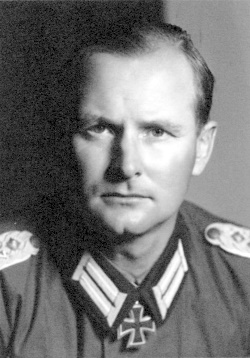 As elements of the division arrived, they were to be readied immediately so as to be available at any time for counter-attacks in a southerly and southwesterly direction. Corps, however, assured Col Gerhard Engel that there was no intention to commit his division before it was fully assembled unless developments compelled a piecemeal commitment of these forces. Arriving among the exhausted and understrength forces of the LXXXI Corps, the 12.Infantry-Division made a deep impression on both the military and the civilian population. Here was the first full-strength, rested, and fresh division, composed of young, healthy, and well-trained men that the Germans in the west had seen in a long time. The appearance of this division greatly boosted the morale of the troops and the civilians in the area. Organized along the lines of a Type 1944 Infantry Division, the 12.Infantry-Division numbered 14800 men, of whom roughly one quarter (about 3800 men) were combat strength. This infantry strength was divided among the 27.Fusilier-Regiment, the 48. and the 89.Grenadier-Regiments, and the 12.Fusilier-Battalion. The division was fully equipped except for its twenty authorized assault guns (FM Walter Model ordered 17 assault guns of 102.Assault-Gun-Brigade attached to 12.Infantry-Division). The 12.Artillery-Regiment had its authorized strength of 9 batteries of 105-MM howitzers and 3 batteries of 150-MM howitzers. The division’s antitank battalion possessed 12 75-MM AT guns.
As elements of the division arrived, they were to be readied immediately so as to be available at any time for counter-attacks in a southerly and southwesterly direction. Corps, however, assured Col Gerhard Engel that there was no intention to commit his division before it was fully assembled unless developments compelled a piecemeal commitment of these forces. Arriving among the exhausted and understrength forces of the LXXXI Corps, the 12.Infantry-Division made a deep impression on both the military and the civilian population. Here was the first full-strength, rested, and fresh division, composed of young, healthy, and well-trained men that the Germans in the west had seen in a long time. The appearance of this division greatly boosted the morale of the troops and the civilians in the area. Organized along the lines of a Type 1944 Infantry Division, the 12.Infantry-Division numbered 14800 men, of whom roughly one quarter (about 3800 men) were combat strength. This infantry strength was divided among the 27.Fusilier-Regiment, the 48. and the 89.Grenadier-Regiments, and the 12.Fusilier-Battalion. The division was fully equipped except for its twenty authorized assault guns (FM Walter Model ordered 17 assault guns of 102.Assault-Gun-Brigade attached to 12.Infantry-Division). The 12.Artillery-Regiment had its authorized strength of 9 batteries of 105-MM howitzers and 3 batteries of 150-MM howitzers. The division’s antitank battalion possessed 12 75-MM AT guns.
In view of the desperate situation in the Aachen area, FM von Rundstedt had requested the 12.Infantry-Division be moved at top speed. Thanks to this priority and the prevailing misty, rainy weather the division had been able to travel across Germany (from East Prussia to the Aachen area) undetected and un-attacked by Allied aircraft and had thus maintained intact the all-important element of surprise. In his Order for the Conduct of Operations and Order of Battle in the West Wall of September 16, 1944, Gen Brandenberger wrote ‘The enemy is expected to continue to make his main effort in the penetration area east of Aachen. The 7.Army will defend the positions from northeast of Maastricht to Aachen and the West Wall to the last man and the last bullet. The penetrations achieved by the enemy will be wiped out. The forward line of bunkers, the Scharnhorst Line, will be regained’.
Specifically, the mission of the LXXXI Corps was twofold. First, its forces were to wipe out American penetrations of the Schill Line east of Aachen. This achieved, the Germans would counterattack on a large scale to throw US forces out of the area east and south of Aachen and to regain full control of the Scharnhorst Line. For this purpose, the 12.Infantry-Division had been attached to the LXXXI Corps. For greater effectiveness the LXXXI Corps sector was shortened, the 353.Infantry-Division with attached elements was now subordinated to the LXXIV Corps so that the new boundary line between the two corps extended now from Eupen via Zweifall and Düren to Cologne. Thus, on September 16, opposite US VII Corps, Gen Schackhad at his disposal the 116. and the 9.Panzer-Divisions and the elements of 12.Infantry-Division now arriving in the area. After the 12.Infantry-Division was fully committed, intentions were for the 116.Panzer to be disengaged and assembled around Eschweiler as corps reserve. Then the 9.Panzer also would be relieved and assembled in the area southeast of Düren at the disposal of 7.Army.
LCXXI Corps Counterattack and Stalemate
After a strong artillery preparation during the night of September 15/16, American forces infiltrated the 116.Panzer-Division’s lines south of Verlautenheide in the morning of September 16 and achieved a penetration by capturing several bunkers just south of the village. The division charged bitterly that local defense units and stragglers committed in the West Wall fortifications have no combat value, no ability to stand their ground’. While the Americans pushed into Verlautenheide and captured the village, another US armored force jumped off from south of Eilendorf and drove eastward into Atsch at 0515. In the Stolberg Corridor, American tanks and infantry assembled during the night between Mausbach and Diepenlinchen while heavy American artillery fire hit the area north of Mausbach and the vicinity of Eschweiler. The Germans also reported American tanks southwest of Schevenhuette and at a hunting lodge south of Zweifall (LXXIV Corps). From these signs, the Germans predicted a very wide push north and northeastward at daybreak aimed toward Eschweiler.
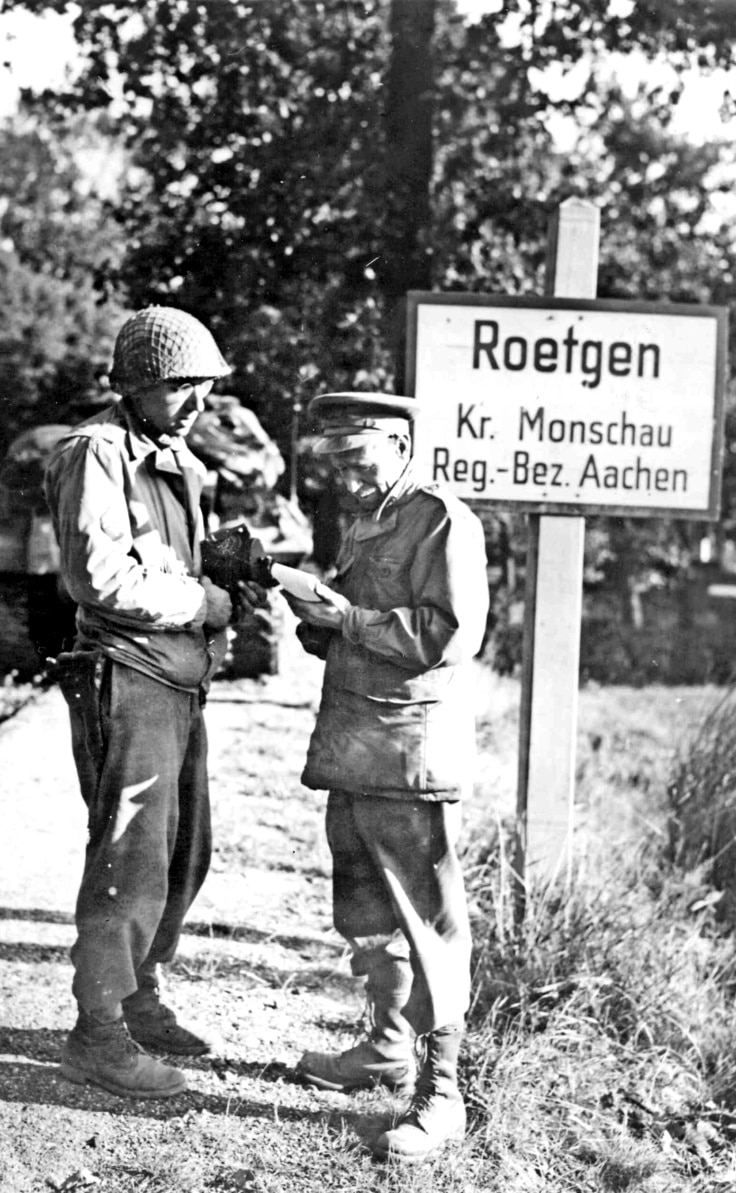 At Mausbach and on the Weissenberg Hill there was little American ground activity during the morning. The Germans stopped some recon patrols probing northeastward from Mausbach toward Werth and Gressenich. Early in the morning of September 16, the eagerly awaited first elements of 12.Infantry-Division arrived. The situation was now too critical for the LXXXI Corps to keep its promise to Col Engel to give him an opportunity for assembling his entire division before it was committed.
At Mausbach and on the Weissenberg Hill there was little American ground activity during the morning. The Germans stopped some recon patrols probing northeastward from Mausbach toward Werth and Gressenich. Early in the morning of September 16, the eagerly awaited first elements of 12.Infantry-Division arrived. The situation was now too critical for the LXXXI Corps to keep its promise to Col Engel to give him an opportunity for assembling his entire division before it was committed.
In view of the American penetration in the area of Verlautenheide and Atsch and the imminently expected drive on Eschweiler, Gen Schack ordered the 27.Fusilier-Regiment to go into action straight from the railroad station. As soon as its 1.Battalion and AT Company had detrained at Jülich, they were moved to the Verlautenheide area by all military and civilian means of transport available – personnel carriers, mail trucks, buses, and the like. The 3.Battalion, arriving in Düren, received orders to move from Eschweiler to the edge of the woods southwest of Schwarzenbruch in the Wuerseler Forest. The 12.Infantry-Division artillery was not expected until 2200 on September 16. Until then the 27.Fusilier-Regiment had to rely on cooperation with the 9.Panzer and the 116.Panzer-Divisions’ artillery.
In the sector of the 116.Panzer, the counter-attack of the 27.Fusilier-Regiment took the US VII Corps forces by surprise and was successful. The 1.Battalion pushed the American spearhead out of Verlautenheide and captured the strategically important high ground around this village. The battalion continued its drive toward Eilendorf and recaptured most of the bunkers along the Verlautenheide – Eilendorf road. Before reaching Eilendorf, however, the attack bogged down in the face of American resistance.
Shortly after noon on September 16, the Americans resumed their drive toward Eschweiler. A two-pronged attack from west and south converged on Buesbach, capturing the village. American forces exerted pressure against the Stolberg area with attacks on Hamm, Schneidmuehle, Muensterbusch and the southern outskirts of Stolberg itself. From the salient at Mausbach and at the Weissenberg Hill, US armor jumped off in a northerly and northeasterly direction. In bitter tank battles which lasted throughout the afternoon the VII Corps forces achieved their deepest penetration of the Stolberg Corridor to date when they captured Diepenlinchen and Gressenich, Krewinkel, and Schevenhuette. The 3.Battalion of the 27.Fusilier-Regiment had moved rapidly through Eschweiler toward the endangered Stolberg area. The battalion captured Atsch at 1330. Continuing south, the battalion was able to regain control of Buesbach – but only for a few hours. By evening, Buesbach was once more American.
In the face of the strong American assault in the Stolberg Corridor the forces of the 27.Fusilier did not suffice to re-establish a coherent German front from Stolberg to Zweifall and to wipe out the American bridgeheads across the Vicht River. The big German counter thrust had to wait until the 12.Infantry-Division could move its own artyllery and its other two infantry regiments into the combat area. In the meantime the 27.Fusilier could do no more than seal off the latest American penetrations with the aid of the remaining elements of 9.Panzer. In view of the very critical situation in this sector German forces were consolidated under one command renamed Kampfgruppe Sperling, and the remaining elements of the 9.Panzer temporarily lost their division status. Effective 2000 on September 16, Kampfgruppe Sperling was attached to the 12.Infantry-Division with the prevision that its forces would be released once the 12.Infantry was fully committed.
 LXXXI Corps to 12.Inf Div 1725 on Sep 16 44, LXXXI Corps KTB, Kampfverlauf. Order, LXXXI Corps to all divs at 2000 on Sep 16 44 LXXXI Corps KTB, Befehle an Div. Report, Gen Brandenberger to A Gp B, Sep 16 44, LXXXI Corps KTB, Befehle : Heeresgruppe, Army, usw.
LXXXI Corps to 12.Inf Div 1725 on Sep 16 44, LXXXI Corps KTB, Kampfverlauf. Order, LXXXI Corps to all divs at 2000 on Sep 16 44 LXXXI Corps KTB, Befehle an Div. Report, Gen Brandenberger to A Gp B, Sep 16 44, LXXXI Corps KTB, Befehle : Heeresgruppe, Army, usw.
There was another motive for attaching the elements of 9.Panzer-Division to the 12.Infantry-Division. In the morning of September 16, Gen Brandenberger had visited the 9.Panzer-Division command post and had asked routine questions regarding the German G-2 estimate of the American situation in the division sector, the location of the 9.Panzer front lines, disposition, and strength of 9.Panzer forces, etc. In attempting to answer these questions, Gen Mueller revealed himself as ignorant of the situation in his own sector, whereupon Gen Brandenberger relieved him of his command on a charge of incompetence. The senior regimental commander, Col Max Sperling, assumed command of 9.Panzer until the evening of September 16. In this study the designation 9.Panzer will continue to be used in reference to these units.
Col Engel now commanded the former sector of 9.Panzer-Division from the Verlautenheide area to the LXXXI Corps southern boundary. By capturing the strategic high ground of Verlautenheide, the 12.Infantry-Division had established a coherent front on its right and had firm contact with 116.Panzer-Division. On the left, however, the German flank lay exposed all the way to Schevenhuette. The most important immediate task was to establish contact with the northern wing of 353.Infantry-Division in the Zweifall – Huertgen area. The combat mission of 12.Infantry-Division was to launch a major counter-attack from the Eschweiler – Wenau line to regain the second band of the West Wall fortifications from the Geisberg Hill to Zweifall. South of Aachen, minor American attacks toward the city on September 16 were warded off by the 60.Panzer-Grenadier-Regiment. A small American penetration south of Steinbrueck was wiped out when the 453.Replacement-Training-Battalion counter-attacked late in the day and recaptured two bunkers. Police and Party had returned to Aachen during the night from Sept 14/15, and the evacuation was once more in full swing.
Gen von Schwerin was in big trouble. When US forces had failed to capture the city contrary to his expectation his compromising letter to the American commander had fallen into the hands of Nazi officials. Because of both this letter and his effort to stop the chaotic exodus from Aachen, von Schwerin was relieved of his command and ordered to stand trial before Hitler’s People’s Court. Rather than comply, von Schwerin decided to remain with his division until the fall of Aachen. He felt that his men would know how to protect him against Nazi henchmen. While his senior regimental commander, Gen Voigtsberger, assumed the duties of division commander until the arrival of Gen von Waldenburg, von Schwerin hid out in a farmer’s home in Kohlscheid, northeast of Laurensberg. The recon platoon of 60.Panzer-Grenadier-Regiment surrounded the farmhouse with a cordon of machine guns. No police detachment trying to arrest their division commander would have escaped alive. When the capture of Aachen did not materialize, Gen von Schwerin finally decided to present himself at the 7.Army headquarters to appear before a military court.
 FM Model to OB WEST, 2330, on Sep 15 44 A Gp B KTB, Operations-Befehle
FM Model to OB WEST, 2330, on Sep 15 44 A Gp B KTB, Operations-Befehle
G-1 to G-3, LXXXI Corps, 1045, on Sep 16 44. 7.Army to LXXXI Corps
1945, on Sep 17 44, LXXXI Corps KTB, Kampfverlauf.
Gen Gerhard von Schwerin; apparently FM von Rundstedt interceded on Gen von Schwerin’s behalf and even proposed – in vain – that the latter be reinstated as Commanding General of 116.Panzer-Division. After some months in the OK Officer Pool (doghouse), von Schwerin was appointed Commanding Officer of 90.Panzer-Grenadier-Division and later Commanding General of LXXVI Panzer Corps in Italy.
Early in the morning of September 17, the 27.Fusilier-Regiment of the 12.Infantry-Division, committed in the Verlautenheide – Stolberg area, resumed its attack to regain the West Wall positions southeast of Elmendorf. In this endeavor, the regiment failed. After gaining insignificant ground and recapturing a few bunkers, the regiment bogged down in the face of heavy American artillery fire and suffered considerable casualties. It also ran short of ammunition and was forced to assume a defensive role for the rest of the day. In the defense, it was more successful. Its 1.Battalion strengthened the contact with the 116.Panzer-Division at Verlautenheide, while the 3.Battalion, on the left, came to the aid of the remaining elements of the 9.Panzer-Division and the 105.Panzer-Brigade had orders to hold Stolberg at all costs. Between Verlautenheide and Stolberg the 27.Fusilier-Regiment, the 9.Panzer-Division and the 105.Panzer-Brigade repulsed all American attacks launched from the Eilendorf area on September 17, and thus enabled the other regiments of the 12.Infantry-Division to carry out their counter thrust against the Mausbach salient without danger to their right flank.











